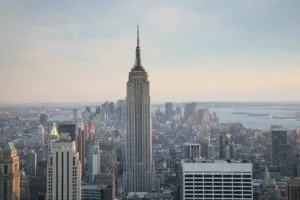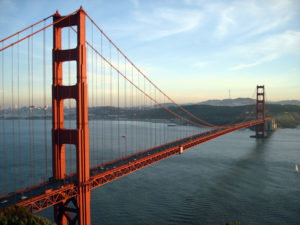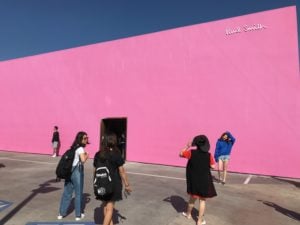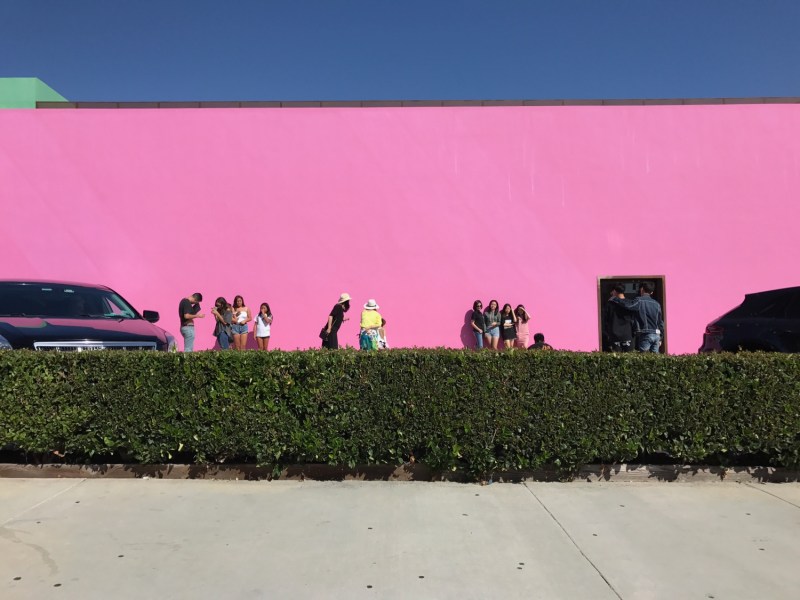On a typical sunny day in Los Angeles, you might notice an abnormally large group of people flocking to an otherwise average parking lot just off Melrose Avenue, a popular shopping destination. Tourists and locals alike line up along the side wall of a Paul Smith retail store, iPhones in hand and faces photo-ready. A sign prohibits the use of DSLR cameras, and a security guard makes sure that things don’t get out of hand.
When it’s finally their turn, each group tries out several different poses, tests various camera filters and brainstorms captions aloud before posting at least one of their photos to Instagram and opening up a spot for the next cluster of friends in line. While this might sound like the scene of a well-timed celebrity sighting, the target of each picture is neither a movie star nor a view of the Hollywood sign. It’s a wall. A plain pink wall.
That plain pink wall has become an icon on social media, especially Instagram, where it has received its very own unofficial account as well as a featured role in pictures from thousands of users. Visitors kiss, jump, dance, make hand shadows and drink colorful Starbucks beverages in front of the wall, posting proof of their photo shoots with the Paul Smith store’s geotag on Instagram. Ironically, the British designer’s logo, which is featured on the upper right corner of the wall, is frequently excluded from photos, and most of the store’s Yelp page is dedicated to reviews of the wall itself rather than the quality of the clothes or the customer service inside.
Obviously, this isn’t the first time that a wall has captured the world’s attention, so what makes this one so popular? It lacks the physical and ideological division of the Berlin Wall or the incredible construction feat of the Great Wall of China. Even the lesser-known outdoor murals that decorate San Francisco tell a story and showcase the talents of the artist. While a historical, environmental or architectural significance usually draws tourists to more traditional landmarks, this wall’s Pepto-Bismol color seems to be the basis of its appeal. “The Pink Wall,” as it has come to be known, is truly characterized by its two titular qualities: its pinkness and its wallness.

In this golden age of social media, the success of a modern landmark is based on its power as a backdrop. It’s not so much the artwork or building or natural wonder itself, but rather how the viewer will look when posing in front of it. And it appears that bright colors and patterns provide the most aesthetically pleasing setting for a strategically staged selfie. The beauty of the pink wall lies in its lack of intricate decoration: You can stand anywhere and still receive the same vivid halo of color.
Given the popularity of photo destinations like the pink wall, modern companies must keep the social media generation in mind when crafting marketing initiatives. For example, several recent color-focused projects in California seemed explicitly designed for Instagram users. The Museum of Ice Cream, which migrated from New York to Los Angeles and recently opened in San Francisco, offers vibrant dessert-themed art installations and encourages both interaction and photography. Similarly, the “pop-up experience” Color Factory, which opened in San Francisco in August, charges visitors $35 to walk through two levels of colorful rooms and take advantage of the exhibit’s photo booth system. Both Bay Area attractions promoted the companies that sponsored them, and both are currently sold out.
With the success of these colorful tourist destinations, one wonders how a popular site can earn the title of “landmark” or “icon.” Who has the power to deem a particular place worthy of the world’s attention: a national government? UNESCO? Social media users? The easiest answer would be the millions of tourists from around the world who seek out the same monuments year after year.
Before social media, we recorded our visits to the Grand Canyon in family photo albums and before that, perhaps via sketching and journaling; the popular appeal of journeying to already-famous destinations is nothing new. But in the past decade or so, we have gained and refined the ability to immediately provide evidence of these voyages to friends and followers online, speeding up the word-of-mouth process that generates revenue from tourism.

Additionally, visiting a national or regional landmark can lead to a feeling of inclusion. There’s a satisfaction in knowing that you too have driven across the Golden Gate Bridge or surveyed New York from atop the Empire State Building. When it comes to cultural significance, we invest a certain degree of trust in other people. If the masses overwhelmingly love a particular painting or building, we can approach the site with an optimistic faith in the rest of humanity’s ability to identify beauty or importance in the world around us.
Obviously individual opinions differ, and certain well-known monuments are bound to feel underwhelming, but we can visit the Taj Mahal or Niagara Falls with the comfort of knowing that millions of people before us found the site worthy of a photo. These are experiences that citizens from around the world place on their bucket lists, and a picture might be the best attempt we can make to capture those moments for future enjoyment.
While photos of colorful walls haven’t completely eclipsed those of more traditional landmarks, the trend is on the rise. Any particularly vivid surface could be spotted and turned into an Instagram landmark overnight, changing the dynamic of the area around it and drawing tourists to previously unfamiliar places.

The line of people waiting to pose in front of the “pink wall” might seem over-the-top, but perhaps the experience is more than just a free backdrop for profile pictures. With every photo uploaded just outside the Paul Smith store, the user acknowledges the value of this particular site, encouraging followers to make the journey as well. It becomes a cultural pilgrimage, providing a strange sort of accomplishment to any who undergo the experience, no matter how unusual (and arguably unnecessary) that experience may be.
Contact Georgina Grant at gagrant ‘at’ stanford.edu.
